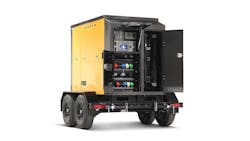Two mobile charging units from Volvo Construction Equipment provide onsite charging for large and compact electric equipment. The Volvo-branded mobile charging units include the PU750, designed for fast-charging larger equipment onsite without needing a converter, and the PU130, a portable Level 2 charger for compact machines.
Volvo CE is partnering with Volvo Penta, Utility Innovation Group (UIG), and Portable Electric to market the charging units.
“We all have a common goal to revolutionize the landscape of sustainable technology within the heavy equipment sector,” said Ray Gallant, VP of sustainability and productivity services for Volvo CE, in a statement. “Collaborating on these products allows us to make significant steps forward in the adoptability of electric machines.”
It announced the partnership at a press event at the 2024 Advanced Clean Transportation Expo. It also presented results from pilot tests of its electric EC230 excavator.
Volvo PU750 mobile charger
UIG designed and built the PU750 working with Volvo CE and Volvo Penta and leveraging the Volvo Group CAST (Common Architecture, Shared Technology) strategy. The PU750 has enough energy to support three to four mid-size machines through twin CCS1 connections before the 792 kWh Volvo-based batteries need to be recharged. When used with the grid interactive UIG power system, the PU750 can seamlessly maximize available AC power and integrate on-site distributed energy assets to enable vehicle charging operations, according to Volvo. Multiple assets can be tracked, managed, and visualized within the GridSure platform, making vehicle and charging power management clear. The PU750 also integrates solar panels to aid in controls and auxiliary system support when it is away from the grid.
The partnership applies Volvo Penta’s battery sub-system to support charging around the world and allows mid-size electric machines to charge on a variety of job sites thanks to its adaptability to multiple infrastructure setups and easy transport.
Volvo PU750 Mobile Charger Specifications
- DC fast vehicle charging: 500 kW
- Storage capacity: 793 kWh
- AC recharging: 480 kW
- AC voltage support: 400V - 38kV
- AC frequency: 50 - 60 Hz
- CCS1 or CCS2 charging connectors
“It’s not always clear what power availability you will have for charging on a job site, but this solution has been strategically developed to put our microgrid integration and GridSure expertise to work in order to dynamically adapt to all utility and on-site generation conditions,” said Derek Tugwell, president of UIG, in a statement.
“We teamed up with UIG last year because of their expertise in integrating multiple assets to maximize on- and off-grid charging possibilities,” said Darren Tasker, VP of Industrial for Volvo Penta North America. “Weaving our Volvo CE teammates into the partnership was always the plan, and it’s exciting to see what has come of this relationship so quickly.”
Volvo PU130 onsite charger
The PU130 is based on Portable Electric’s proprietary 48-volt direct current fast charging (DCFC) technology. It provides the ability to charge equipment in less than an hour with 130 kWh of energy storage capacity and a 20 kW charge rate. In addition to charging equipment, the PU130 can simultaneously provide 40 kW of site power.
Volvo PU130 Mobile Charger Specifications
- AC output: 40 kW
- Low voltage DC fast charging: 20 kW
- Storage capacity: 130 kWh
EC230 pilot testing
An evaluation of a Volvo EC230 electric excavator demonstrated a 74% reduction in hourly costs and a two-thirds reduction in hourly carbon emission, the company said.
Skanska used the EC230 electric excavator in a 90-day pilot program to load trucks of export material from an underground tunnel as part of a transit line renovation in Los Angeles, California.
Gallant said that the cost savings were as important as the carbon cutting.
“The cost savings are just as important because if these solutions don’t make financial sense in addition to the emissions reduction, adoption will lag,” Gallant said.
In another 90-day pilot, with Sunbelt Rentals, Volvo said the EC230 electric excavator delivered an 83% reduction in costs while reducing carbon by 80%. In the Sunbelt pilot, the excavator was doing general earthmoving for a large building project. The savings were higher because it was a longer, tougher duty cycle, according to Volvo, so the fuel and overall cost offset was even greater in comparison to using a diesel machine.
Gallant used these numbers to suggest that the amount of carbon produced in the manufacture of the EC230 is offset by the reduction in emissions during operation of the machine.
“This project demonstrated that, even though production of the machine has a higher carbon footprint in comparison to its diesel equivalent, the fuel savings and carbon reduction offset that in just over 800 hours of use,” Gallant said.
About the Author
Rod Sutton
Sutton served as the editorial lead of Construction Equipment from 2001 through 2025.


